Table of Contents[Hide][Show]
How to make homemade ghee on the stovetop quickly and easily for a healthy cooking fat that is shelf stable and nourishing.
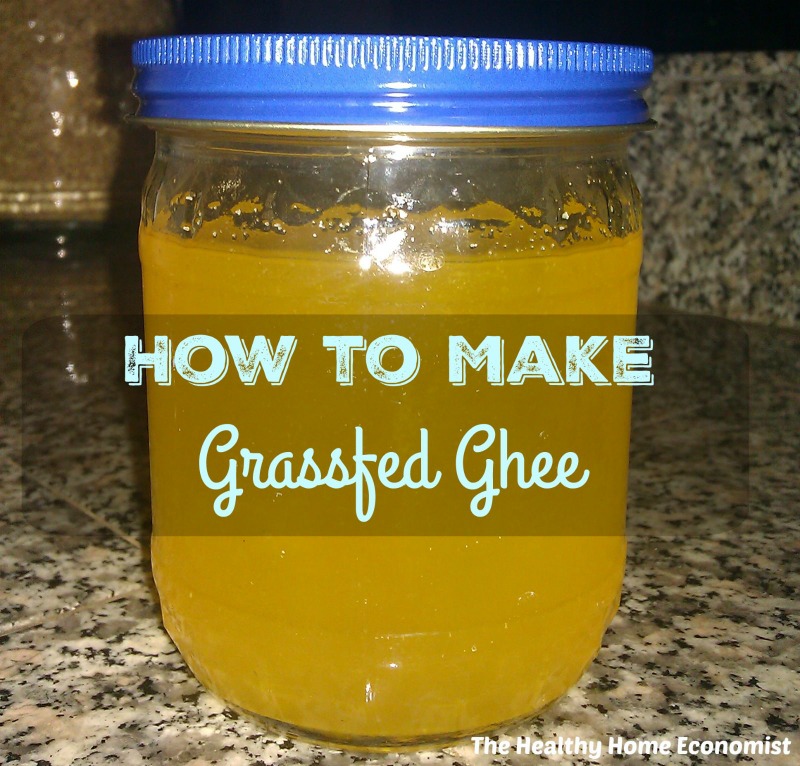
Knowing how to make ghee is simply a must for any Traditional Cook. Clarified butter as it is also known, has been used for thousands of years by Indian cultures. In fact, traces of ghee have been found on fragments of Indian pottery dating as far back as 6500 BC!
When in a liquid state and made from unheated butter, ghee is called butter oil. Dr. Weston A. Price discovered that butter oil and cod liver oil work synergistically to supercharge absorption of Vitamins A, D, and K2 known as the X-factor.
Dr. Price always carried flasks of cod liver oil and butter oil to the bedside of very ill patients. More often than not, he was able to revive them with a few drops of each under the tongue. Using cod liver oil or butter oil separately did not have the same deathbed reviving effects.
Benefits of Ghee over Other Cooking Fats
It is best to know how to make clarified butter oil or ghee yourself rather than buying from the store. Notice the picture above of a jar that I made myself with pastured butter from a local farm. It is so yellow!
Commercial ghee from the store is a pale yellow, indicating lower nutritional value from cows eating grain mix instead of fresh green grass.
Ghee from the store is also ridiculously expensive, so learning to make it yourself is not only a more nutritious way to go, it is very cost-effective.
I make clarified butter oil for about half the cost of what it would be to buy it at the health food store.
Unlike butter, ghee does not need refrigeration and keeps well on the counter or pantry for many months. Keeping a jar in the pantry for a quick veggie saute is very convenient!
Another benefit of ghee is that it is easier to digest as all the milk solids (proteins) have been removed from the butter. Very frequently, even those with a true dairy allergy find that ghee presents no trouble for them.
Another advantage to using clarified butter instead of plain grass-fed butter is that the grassy taste and sometimes cheesy smell of the butter is eliminated.
Therefore, by learning to make clarified butter oil from grass-fed butter, you will find that you now have a healthy fat for cooking that does not displease your family with a cheesy odor. This can sometimes happen with grass-fed butter alone.
Homemade Grass-Fed Ghee
The recipe and video lesson below covers how to make this healthy and indispensable fat for use in your own kitchen.
I also cover how to make clarified butter capsules. This is a convenient way to take butter oil with your daily dose of cod liver oil.
If you are spending money on high vitamin cod liver oil (this is the brand I’ve used since 2015) it is a must to be taking it with clarified butter oil. This supercharges the beneficial effects!
Note that it is not advisable to make ghee from homemade raw butter. The heating process causes a loss of the enzyme and probiotics in this special food.
Prefer to Buy?
If after reviewing the recipe and video demo below you decide to buy instead, I would recommend this vetted source as a premier retailer of quality grass-fed ghee. Plain, cultured, and herb-flavored varieties are all available including a coconut oil/ghee blend.
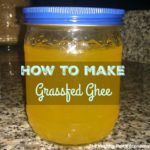
How to Make Ghee
This simple recipe for making ghee can be accomplished on the stovetop in just a few minutes.
Ingredients
- 1 lb butter preferably grassfed and organic
- 1 wide mouthed mason jar quart size
- 1 cheesecloth fine mesh
- 1 funnel
Instructions
-
Place pound of butter in a medium sized pot or stove safe glass bowl. Turn heat on low and allow the butter to gently liquefy.
-
Turn heat to medium-low and gently remove foam that comes to the top of the melted butter with a slotted spoon.
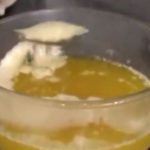
-
After removing the foam, allow the melted butter to simmer on medium-low heat for 5-10 minutes longer to allow all the milk solids to settle out on the bottom of the bowl. You will know when the separation process is complete as the solids will be slightly brown on the bottom and the clarified butter will be completely clear and transparent.
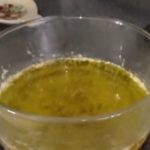
-
Line a funnel placed into the open end of a wide mouthed mason jar with a fine mesh cheesecloth.
-
Pour the clarified butter into the funnel so that it is strained through the cheesecloth as it enters the mason jar.
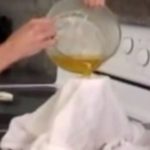
-
Allow the finished ghee to cool in the mason jar. When room temperature, fasten the lid on tightly and store in the pantry as a convenient and incredibly healthy cooking oil for all your kitchen needs.








I got stumped at “unsalted grass-fed butter”! Jumping past this gorilla-in-the-room is futile, for I (and the bulk of humanity) will not have any idea what this is, or where to get it.
My son has a terrible dairy allergy and I’ve been debating for years now whether or not he can have ghee. I desperately want him to have it because of the nutritional value but am afraid to because he’s had anaphalaxis to dairy before. Does anyone have a successful experience with giving high quality ghee to a person with dairy allergy? I somehow feel like the butter oil will actually IMPROVE his allergy but also do not want to send my 3 year old to the hospital. Any advice is greatly appreciated!
Just curious, is ghee healthier than grass fed organic butter and if so, why? Thanks for the video!
Thank you for this great Information.. very helpful.. 😀
I need a butter substitute, my child has an anphylactic allergy to all forms of dairy protein!
how about coconut oil?
Hi there! I’m new to most of this – just bought Nourishing Traditions recently and am re-vamping my kitchen & lifestyle. Haven’t finished reading NT yet, so not sure if this question is answered there: what do you do with the milk proteins you strained out of the ghee? Do they just get thrown out?
Thanks!
THE FOAM THAT WAS STRAINED OFF THE TOP ARE STILL EDIBLE AND CAN BE USED AS BUTTER STILL, OR RENDERED IN WITH OTHER OILS TO MAKE LYE SOAP, FOR ANOTHER IDEA…
I am on a waiting list to purchase a herd-share in order to obtain raw milk. In the meantime, can I make quality ghee with cultured pasture butter (Organic Valley)? I just tried a small batch…got foam, but no milk solids on the bottom. ??
Also…is there any vitamin K2 in bacon fat from organic pastured pork purchased at a local farm?
Thanks so much for this! I am trying to heal 2 cavities in my son and also my own mouth. This has been very helpful to me and i will definitely be trying this! 🙂
Hi,
Thanks for sharing. I am a bit confused though. I read in Eat Fat, Lose Fat by Mary Enig and Sally Fallon that ghee or clarified butter is NOT same as butter oil, especially because it’s nutrient content is far less than butter oil, hence not making it a super food.
Also, this site, states the same.
What are your thoughts?
Ghee is definitely butter oil. It’s not raw though which is the distinction some make.
Exactly, so that is why the nutrition is lost in the heat process, which is in a more concentrated form in butter oil, which uses centrifugal method. Anyway, I am just wondering if I should stick with ghee (I am Indian) and use it in my cooking, and was initially very happy to learn that it is same as what Dr. Weston Price was talking about, but then when I read that there def is a distinction, so health benefits might be compromised. However, it has to be effective to some degree to have worked for your son’s cavity. Oh how much I wish life would be simple.
Hi Sarah,
I have been meaning to write to you for some time. Anyway, I hav been reading Nourishing Traditions, and came across a point which would basically explain if ghee is not “raw” like butter oil, then how did it help reverse your son’s cavity. Like mentioned by Dr. Price and Sally Fallon, it’s the X factor or Actavator X that is the key in producing the benefits, and based on her book, Nourishing Traditions, the X factor is not affected by pasteurization. So heat will not kill it, given of course that the butter used for making ghee, is made from grass fed cows. Hope this helps clear out some air 🙂
Video: How to Make Butter Oil
http://t.co/oVgH6Wjn